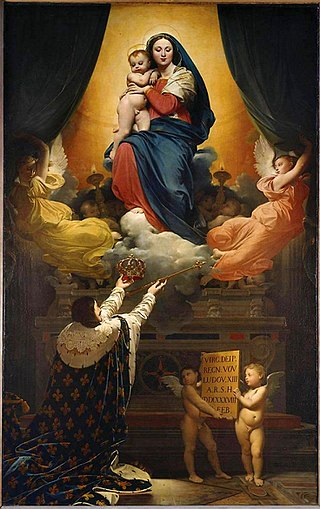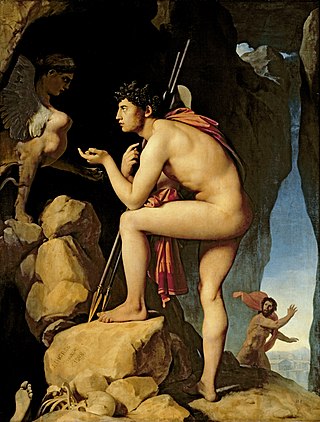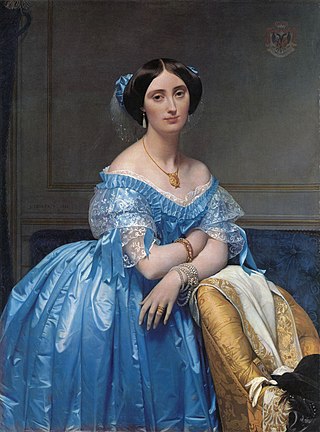
Jean-Auguste-Dominique Ingres was a French Neoclassical painter. Ingres was profoundly influenced by past artistic traditions and aspired to become the guardian of academic orthodoxy against the ascendant Romantic style. Although he considered himself a painter of history in the tradition of Nicolas Poussin and Jacques-Louis David, it is his portraits, both painted and drawn, that are recognized as his greatest legacy. His expressive distortions of form and space made him an important precursor of modern art, influencing Picasso, Matisse and other modernists.

Napoleon I on his Imperial Throne is an 1806 portrait of Napoleon I of France in his coronation costume, painted by the French painter Jean-Auguste-Dominique Ingres.

Madame Moitessier is a portrait of Marie-Clotilde-Inès Moitessier begun in 1844 and completed in 1856 by Jean-Auguste-Dominique Ingres. The portrait, which depicts Madame Moitessier seated, is now in the collection of the National Gallery in London, which acquired it in 1936.

Portrait of Monsieur Bertin is an 1832 oil on canvas painting by Jean-Auguste-Dominique Ingres. It depicts Louis-François Bertin (1766–1841), the French writer, art collector and director of the pro-royalist Journal des débats. Ingres completed the portrait during his first period of success; having achieved acclaim as a history painter, he accepted portrait commissions with reluctance, regarding them as a distraction from more important work. Bertin was a friend and a politically active member of the French upper-middle class. Ingres presents him as a personification of the commercially minded leaders of the liberal reign of Louis Philippe I. He is physically imposing and self-assured, but his real-life personality shines through – warm, wry and engaging to those who had earned his trust.

Baronne de Rothschild is an 1848 portrait by the French Neoclassical artist Jean-Auguste-Dominique Ingres. The sitter, Betty de Rothschild (1805–1886) had married her paternal uncle banker James Mayer de Rothschild and was one of the wealthiest women in Europe, and one of the foremost Parisian patrons of the arts. Her beauty and elegance were widely known and celebrated, and inspired Heinrich Heine's poem The Angel. For her portrait, which is painted in oil on canvas, Ingres sought to infuse symbols of her material wealth with the dignity, grace and beauty of Renaissance art, especially that of Raphael, while at the same time adhering to the command of line as practiced by Jan van Eyck. It is this combination which, according to art historians, places Ingres so far apart from his early modernist contemporaries.

The Martyrdom of Saint Symphorian is an 1834 painting by Jean-Auguste-Dominique Ingres. It shows the death of Saint Symphorian, the first Christian martyr in Gaul. Painted in oil on canvas and measuring 407 x 339 cm, it is now in Autun Cathedral. Although Ingres considered the painting—completed only after ten years of diligent work—one of his crowning achievements, it was criticized harshly when he exhibited it in the Paris Salon of 1834. It subsequently has been considered emblematic of Ingres' misguided ambition to excel as a history painter.

Raphael and La Fornarina was painted in 1813, in Italy, by Jean-Auguste-Dominique Ingres. It is the first of five versions of the painting, which he completed between 1813 and his death in 1867. In 1814 his first version was exhibited at the Salon. The work shows the renowned painter, Raphael, sitting in his studio with his mistress, La Fornarina, on his knee. His embrace reflects his affection and desire for her, while his gaze towards his own artwork, his portrait of his mistress, indicates his love for art. This contrast represents the painter's major conflict between who he loves and what he loves. The mistress makes eye contact with the viewer and her posture, specifically her arms resting on his shoulders, shows how proud and satisfied she is with being his mistress and inspiration. The Fornarina's sensual gaze at the viewer claims her importance and place both within the artist's studio and profession.

The Vow of Louis XIII is an 1824 painting by Jean-Auguste-Dominique Ingres, now in Montauban Cathedral. The oil painting shows a vow to the Virgin Mary by Louis XIII of France.

Roger Freeing Angelica or Ruggiero Freeing Angelica is an 1819 painting by Jean-Auguste-Dominique Ingres, inspired by Orlando Furioso by Ariosto. An oil painting on canvas measuring 147 x 199 cm, it is owned by the Louvre. Ingres subsequently painted several variants of the composition.

Oedipus and the Sphinx is a painting by the French Neoclassical artist Jean-Auguste-Dominique Ingres. Originally a student work painted in 1808, it was enlarged and completed in 1827. The painting depicts Oedipus explaining the riddle of the Sphinx. An oil painting on canvas, it measures 189 x 144 cm, and is in the Louvre, which acquired it in 1878.

Louise de Broglie, Countess d'Haussonville was a French essayist and biographer, and a member of the House of Broglie, a distinguished French family. A granddaughter of the novelist Germaine de Staël, she was considered independent, liberal, and outspoken. Her 1845 portrait by Jean-Auguste-Dominique Ingres, which took three years to complete, has been exhibited in the Frick Collection in New York City since the 1930s.

Portrait of Madame de Senonnes is an 1816 painting by Jean-Auguste-Dominique Ingres. It shows Madame de Senonnes, née Marie-Genevieve-Marguerite Marcoz, viscountess of Senonnes (1783–1828). Marcoz was 31 when the portrait was completed. Ingres had earlier portrayed her in a drawing of 1813.

Portrait of Madame Duvaucey is an 1807 oil on canvas painting by Jean-Auguste-Dominique Ingres. It shows Antonia Duvauçey of Nittis, the lover of Charles-Jean-Marie Alquier, then ambassador to the Holy See. Duvaucey is positioned in a flat pictorial space, gazing frontally at the viewer, dressed in lavish clothing and accessories. The portrait is the first female portrait painted during the artist's stay in Rome. Portrait of Madame Duvaucey is acclaimed for exhibiting her enigmatic charm, and as "not a portrait that gives pleasure..[but]...a portrait that gives rise to dreams".

Portrait of Madame Aymon, La Belle Zélie is an 1806 oil on canvas painting by the French artist Jean-Auguste-Dominique Ingres. The painting is one of Ingres' early painted portraits, completed just before his first stay in Rome. It first came to public notice during an 1867 Ingres exhibition in Paris, and was acquired by the Musée des Beaux-Arts de Rouen in 1870.

The Princesse de Broglie is an oil-on-canvas painting by the French Neoclassical artist Jean-Auguste-Dominique Ingres. It was painted between 1851 and 1853, and shows Pauline de Broglie, who adopted the courtesy title 'Princesse'. Born Pauline de Galard de Brassac de Béarn, she married Albert de Broglie, the future 28th Prime Minister of France, in 1845. Pauline was 28 at the time of the painting's completion. She was highly intelligent and widely known for her beauty, but she suffered from profound shyness and the painting captures her melancholia. Pauline contracted tuberculosis in her early 30s and died in 1860 aged 35. Although Albert lived until 1901, he was heartbroken and did not remarry.

Portrait of Charles Marcotte is an 1810 oil on canvas painting by the French Neoclassical artist Jean-Auguste-Dominique Ingres, completed during the artists first stay in Rome. Charles Marie Jean Baptiste Marcotte (1773-1864) was a long term friend, loyal supporter and adviser to Ingres, and commissioned a number of portraits of his family and friends, as well as works such as Odalisque with Slave (1839). He was 23 years in age when the portrait was painted, and serving as inspector general for Waters and Forests in Napoleonic Rome.

Portrait of Marie-Françoise Rivière is a c. 1805 oil-on-canvas painting by the French Neoclassical artist Jean-Auguste-Dominique Ingres.

Portrait of Paul Lemoyne is an oil on canvas painting by the French Neoclassical artist Jean-Auguste-Dominique Ingres, completed between 1810 and 1811. It his held at the Nelson-Atkins Museum of Art, Kansas City. The model is Paul Lemoyne (1784–1883), a French sculptor, who visited Ingres during his first stay in Rome, when this portrait was executed. He is depicted as youthful, dashing, fiery, dark and handsome. Lemoyne is shown in an unguarded and informal pose, suggesting that the work completed as a gift for a friend rather than as a paid commission. The dark black and green background seems splashed on, and serves to accentuate the subject's dark facial features and black hair. Lemoyne looks disheveled, with rough hair and open shirt collars.

Portrait of Philibert Rivière is a c. 1805 oil on canvas painting by the French Neoclassical artist Jean-Auguste-Dominique Ingres. It was commissioned by Philibert Rivière de L'Isle, an influential court official in the Napoleonic Empire, along with portraits of his wife, Philibert and their daughter, Caroline.

Portrait of Caroline Murat, Queen of Naples is an 1814 oil on canvas painting by the French Neoclassical artist Jean-Auguste-Dominique Ingres. Caroline Murat, née Bonaparte, was the sister of Napoleon, and married Joachim Murat, a Marshal of France and Admiral of France, and later King of Naples. Caroline commissioned the portrait as part of an effort to convey her standing and worth to reign as Queen of Naples during an unstable political climate.
























